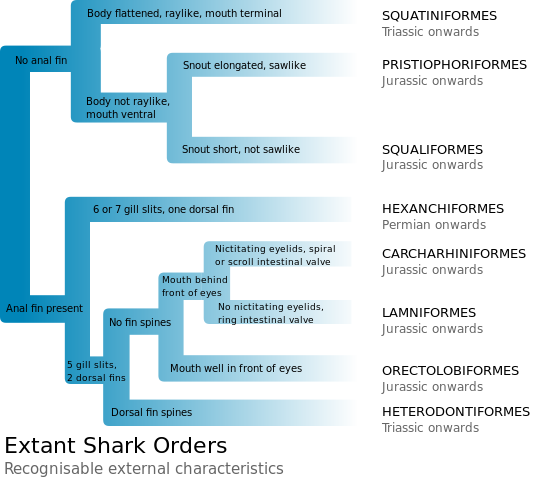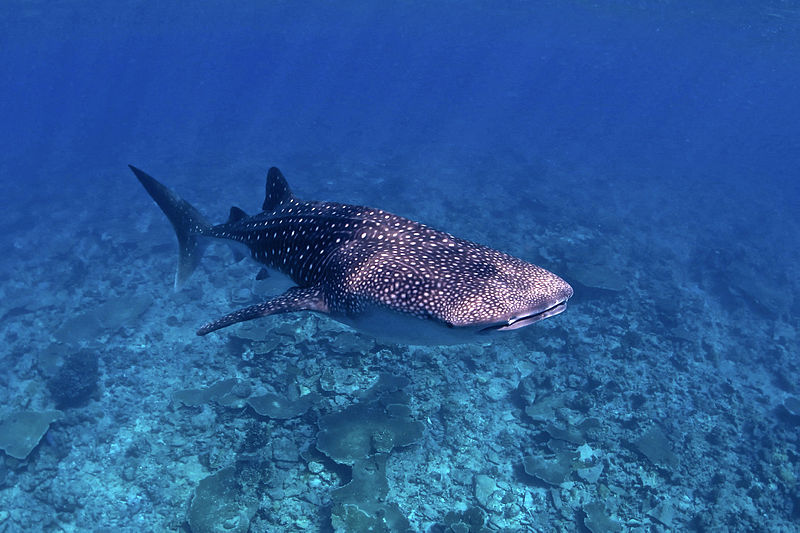Classification
Common Name – Whale Shark
Scientific Name - Rhincodon typus
Rhincodon meaning "rasp tooth"
typus meaning "type"
Kingdom – Metazoa
Characteristics: Members of Metazoa, the Animal Kingdom, are
multicellular
organisms. Animals are heterotrophs, meaning that they must consume
other
organisms rather than having the ability to make their own food.
Many animals
reproduce sexually, though not all. Unlike plant cells, animal cells
do not have cell
walls because they have evolved other structures for support. Most
animals are
mobile at some point in their life, contributing to their
heterotrophic ways.
Phylum – Chordata
Characteristics: The Chordates are characterized by structures such
as the notochord
and their hollow nerve chord. The notochord is a flexible rod on the
dorsal side of a
Chordate and is present at some point in the Chordate lifecycle.
Chordates also differ
from other Phyla because of the presence of pharyngeal slits, which
connect the
pharynx with the gills, for example. Chordates also have, at one
point in their life, a
tail that extends beyond the anus. The chordates include animals
such as humans
(you and I) along with other interesting organisms such as
Class –
Chondrichthyes
Characteristics: Members of this class are also known as
cartilaginous fish because
their skeletons are made up of cartilage rather than bone. These
fish have jaws and
paired fins, and also do not possess a swim bladder. These fish lack
ribs making it
very dangerous for them to be out of the water. Most sharks in this
class have
heterocercal tails which are tails with uneven lobes with one being
higher and longer
than the other. Other interesting organisms within this class
include
stingrays,
Manta rays, and the
Great White Shark!
Order –
Orectolobiformes
Characteristics: Members of this order are also known as carpet
sharks because they
traditionally inhabit coral reefs. All members of this class exhibit
mouths that are
located completely in front of their eyes. Orectolobiformes also
lack spines on both
of their dorsal fins and have five pairs of gill slits. Unique to
this Order also is the
presence of an anal fin.
Family –
Rhincodontidae
Genus – Rhincodon
Species – typus
Characteristics: Whale sharks are the only members of the family
Rhincodontidae.
To find out characteristics of this amazing fish, explore the rest
of the website!
Classification Information found on the
Animal Diversity Web! Check it out!
Interested in knowing how whale sharks fit in
and compare with other animals of
the world? Take a look at the following Phylogenetic trees that show
how Rhincodon
typus is related to other animals!

This first phylogenetic tree is of
the extant (living) shark orders!
Follow the tree up to the
Orectolobiformes and notice the
characteristics that set them apart
from other orders. The
characteristic specific to the order
of Rhincodon typus is the
presence of the mouth being well
in front of the eyes.

The phylogenetic tree pictured to the
right shows all of the Animal Phyla.
Whale sharks are a member of the
Chordata phylum. Some
characteristics special to the
and the closely related Echinoderms
are bilateral symmetry, three layers
of true tissues, and deuterostomal
development (meaning the mouth
forms second). Look above to see
characteristics exclusive to
Chordates! This tree gives a good
indication about where Chordates fall
in relation to all other animals!
Chordates are far from
Porifera in characteristics and adaptations.
To learn more
about Porifera, here is a website all about
sea sponges! Other organisms that differ
greatly from Chordates that are interesting to learn about include
the
Giant Pacific
Octopus, which is a member of the Mollusca Phylum! Even within
the Chordates
exists a lot of variation. If you want to learn about some examples
of this diversity,
check out these websites on the
Moose,
Ostrich, and
Pygmy Rattlesnake! Enjoy
learning!

